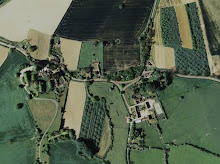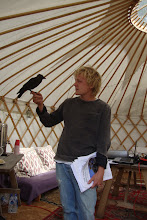.JPG)
Today I made up a flask of hot chocolate and scampered into the 1920s orchard above Charingworth village to make a real start on the pruning. I was only using a pruning saw as each tree needs a certain amount of trimming before its safe to get the pole pruner involved. The tree pictured is one of the largest in this orchard - can you see the water shoots protruding vertically from the main boughs? This is regrowth from the last pruning and tells me the tree is healthy and vigorous. You can also see a fair amount of congestion in the lower fruiting branches that needs to be reduced.
.JPG)
I plan to thin these congested lower areas by hand. I have three main things in mind while doing this:
1) to take in any excessive growth lessening the weight carried by the main boughs, thus minimising the chance of major splitting.
2) increase the gap between these fruit bearing branches and the floor to improve air circulation and (when the time comes) keep the trees out of reach of hungry sheeps
3) to thin the branches out allowing more air and light to the developing fruit
One thing to remember when doing this is to consider the characteristics the variety of apple tree you are pruning. Bramleys, for example, only fruit on growth that is at least two years old. This means that if I went around clipping the tips off all the shoots no fruiting buds would form in the coming season. Once this thinning is done I will have the room needed to safely manoeuvre my fairly unwieldy pole pruner that will help me to quickly remove most of the vertical water shoots.

Copyright © Cass Turnbull Plant Amnesty.
Basically there is a LOT of different advice about pruning fruit trees around. I need establish what pruning will keep the trees in the best health for the longest time. I think the trees I tackled last year were pruned too hard and so I plan to experiment with a few different approaches within a general framework of reducing the chances of splitting, raising the canopy, increasing fruit health and preserving ecological value (in scenarios where it doesn't immediately condemn the tree).



No comments:
Post a Comment